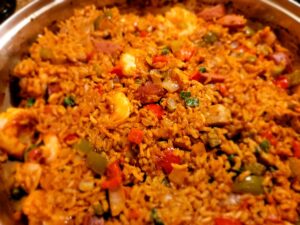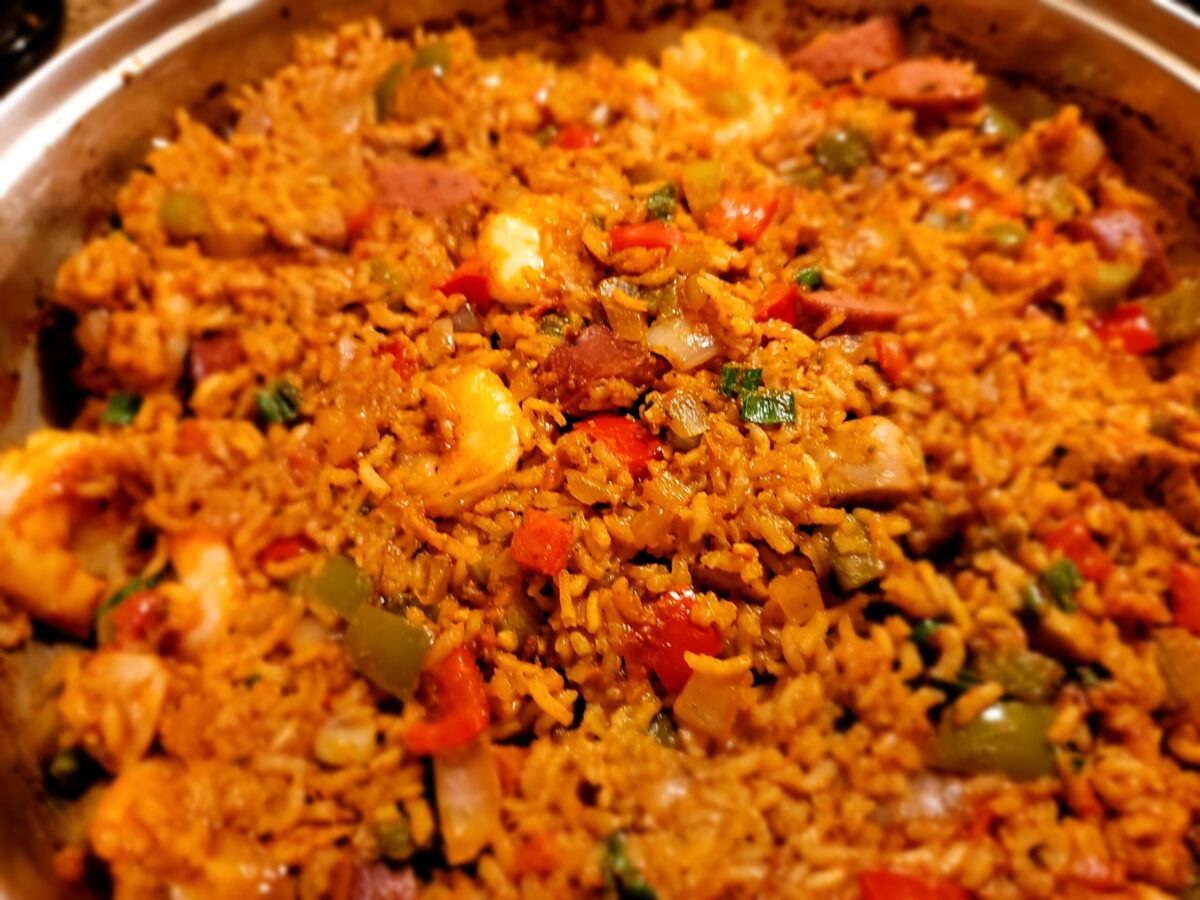Jambalaya is a rice dish with shrimp, chicken, and sausage cooked in a creole seasoned chicken broth. If you’ve experienced creole cooking, this jambalaya recipe is an easy and inexpensive place to start. The reason we keep this jambalaya recipe easy, is that as busy home chefs we don’t always have the luxury of cooking for hours at the end of the day.
Jambalaya starts with the creole “holy trinity” of bell peppers, celery and onion. This trinity is the base of many flavors from this region. Many other dishes such as crawfish étouffée, gumbo, and jambalaya all start from this base. Traditionally made with green bell peppers, this jambalaya recipe uses equal parts of red and green bell peppers. Red, orange and yellow peppers are all interchangeable, and add just a hint of sweetness to balance the spicy creole seasoning.
Tip 1: What’s the ingredients for jambalaya?
This recipe uses a combination of chicken, shrimp and sausage. Regionally authentic recipes may use different proteins, but here in Ohio I am limited to what is available. Here is what I use, but feel free to experiment!
Boneless, skinless chicken thighs are not only inexpensive but add flavor. Chicken breasts, if used, may taste dry if overcooked. The key is to cut the thighs into bite sized pieces before cooking. This way you can brown the chicken all over. When you “brown” a protein, you are caramelizing the natural sugars inside. This not only enhances the overall flavor, but texture as well.
Andouille sausage is a coarse-grained smoked sausage made using pork, garlic, pepper, onions, wine, and seasonings. It is probably my favorite part of the jambalaya recipe. If andouille is not available in your area, you can substitute some other sausages. Pre-cooked sausages such as smoked sausage and kielbasa are similar in texture and are legitimate substitutes for any jambalaya recipe. Occasionally my local market will even have chorizo available, but it is typically uncooked. Chorizo is “spicy” like andouille, but will have a different texture AND need cooked longer.
As I’ve already mentioned, I live in Ohio. Fresh shrimp are not an option for me. But many frozen verities are available, and I highly suggest uncooked, deveined shrimp. I typically choose something close to the 20-36 count per pound size. Larger shrimp, if used, may not be “bite sized” and should be avoided if possible.
I would try to avoid fully cooked shrimp. It is typically already rubbery, and will only get worse when cooked again in our jambalaya recipe. If precooked shrimp is your only option, I would not sauté it. Simply skip that step and add it at the end of the jambalaya recipe as instructed.
Tip 2: Jambalaya Recipe Easy Spice Mixture
Paprika, salt and garlic form the base flavor profile of any jambalaya recipe. Onion, cayenne and dried herbs further complement the base flavors. I use plain paprika, but mixing a small amount of smoked paprika or Hungarian hot paprika may appeal to some as well. Paprika does not store as well as some spices, so if it has been in your pantry for more than a year you may want to buy a fresh batch.
This jambalaya recipe already brings some pretty good heat, so you may want to add less cayenne and paprika until you have tasted it. Spice can always be added, but it can rarely be taken away!
Tip 3: Cooking Rice for our Jambalaya Recipe
White rice is the most available to me locally, and it is what I use in my own jambalaya recipe. I would avoid long grain rice or other flavored rice. To cook, I prefer to let the rice cook in the oven to make this jambalaya recipe easy. Stovetop methods such as “bring to boil and then simmer” are too subjective for my tastes, and sometime yield undesirable results. The base cook time for the rice is in this jambalaya recipe is roughly 25 minutes, but it has taken longer for me on occasion. The key is to check for tenderness after 25 minutes, and every 5 to 10 minutes afterwards until done.



